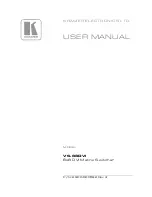
Section 7: Command reference
Models 707B and 708B Switching Matrix Reference Manual
7-138
707B-901-01 Rev. A / August 2010
Note that each node independently sets its operation complete bits in its own status model. Any nodes not
actively performing overlapped commands will set their bits immediately. All remaining nodes will set their own
bits as they complete their own overlapped commands.
For additional information, see Status Model.
Also see
(on page 7-243)
print()
This function returns the value of the argument.
Type
TSP-Link accessible
Affected by
Where saved
Default value
Function No
Usage
print(value1)
print(value1, value2)
print(value1, ..., valueN)
value1
The first argument to return
value2
The second argument to return
valueN
The last argument to return
Details
TSP-enabled instruments do not have inherent query commands. Like any other scripting environment, the
print()
command and other related
print()
commands generate output. The
print()
command creates
one response message.
Example
x = 10
print(x)
Example of an output response message:
1.001
Note that your output might be different if you set
your ASCII precision setting to a different value.
Also see
None
printbuffer()
This function prints data from tables or reading buffer subtables.
Type
TSP-Link accessible
Affected by
Where saved
Default value
Function No
















































